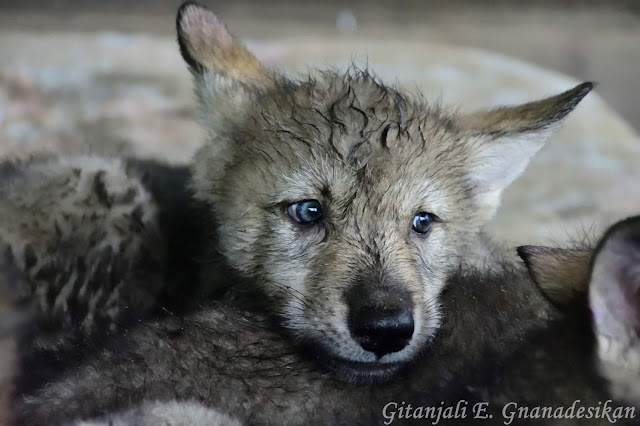Wolves—like dogs—are born with their eyes and ears closed. Wolf puppies also have a little white star on their chests that fades as they grow. Here is Piglet at approximately ten days old, just retrieved from the den.
His sister Kanga's eyes were just slightly cracked open, but still filmy and blind.
By three weeks old, their eyes are fully open and they are starting to walk around and investigate their surroundings.

Like many other mammals, including many humans, wolves are born with dark blue eyes that change over the first few months, sometimes darkening to brown and sometimes lightening to grey.
Shiner and Dace, the next two to be introduced, are pictured here at about six weeks old. They were named after minnows because they were fished out of the den with a net. They are both a bit nervous here, as they are outdoors with the older pups for the first time. But they soon adjusted.
This is Jane. The light patch on her left shoulder is the result of shaving, one method that staff and researchers use to tell the pups apart, in addition to size, coloration, sex, and other characteristics. The shavings are especially useful for identifying individuals in videos, when some of those other characteristics are more difficult or even impossible to assess.
Everyone who meets or sees photos of Gallo remarks on his beautiful eyes. He's not quite 7 weeks old here.
Plastic bottles are a favorite toy of all the WSC wolves.
Puppies learning to howl are hilarious. When they hear a nearby adult howling, they have a tendency to break into howls themselves but then stop and look confused, as if asking: "why did I do that?"
I always used the shape of her ears to identify Ryn, one of the shyest of her litter. Here she is on her first afternoon in the outdoor pen.
 |
| "My chicken!" (Jane) |
The pups like to sleep under things that form enclosed spaces. Although there was a nice wooden house in their enclosure, they preferred to den underneath it and would dig around the edges to ensure access as they grew.
 |
| "What's going on out there?" |
I think this is Artemis (a very fitting name, don't you think?), although at different angles and ages it can be difficult to tell (hence the shavings, which are not visible here).
This is Freya at about 7.5 weeks old, enjoying the greenery.
Like dog puppies, wolf pups like to cuddle, often in piles. I believe these are Jane and Artemis, but they were soon joined by most of the other pups!
A few moments later...
This is Wyatt snuggling with the other pups on the mattress after a rainstorm. They were definitely less than thrilled about getting wet.
I found the pups to be both beautiful and adorable, with amusing and endearing individual personalities. Freya was one of the most social pups, which helped me get several good photos of her.
 |
| Freya. She fell asleep just moments later. |
This is Dwayne at 9 weeks old. He was the largest of the pups, with extra large ears and paws, and named after Dwayne Johnson. He was pretty laid back and social, and he enjoyed physical contact with humans, which not all the pups did. The pink stuff on his ears and head is fly repellent, to protect from biting flies that are especially drawn to the exposed skin on ears.
Just like dog puppies, the wolf pups played a lot with each other (although less with us), often rough housing.
Although on the whole wolves look quite different from dogs--even from an early age--occasionally they remind one of "man's best friend".
If you're looking for differences between the two, though, check the ears, the shape of the face (especially through the eyes and muzzle), the long legs, and the big paws.
 |
| Madoni wants to know what's on top of her den. Answer: a video camera. |
 |
| Dace at almost 10 weeks old. |
There is something so captivating about wolves howling. And its a totally different sound from dog howls, and much more harmonious, at least in my opinion. The puppies' howls were amusingly shrill, however, and always surprising to anyone I was ever on the phone with.
The next few photos show the pups at about 12 weeks old. They are starting to look less distinctly puppyish and more like miniature adult wolves. They still have a lot of growth to come, but their proportions and coloration have already changed considerably from when we first met them in May.
 |
| "I'm just going to rest my eyes for a second..." |
This photo of Madoni is one of my favorites from the entire summer.
The oldest pups were about 13 weeks old when I left and about to be introduced to the two adults who would act as foster parents, establishing order within their pack of unruly pups and teaching them how to be wolves, after a few months of learning how to be less afraid of humans.
By the end of the summer, my sneakers had been chewed so thoroughly that they had multiple holes in them and were missing chunks of the soles, tongues, and shoelaces. I knew I wouldn't use them for anything else, so I left them with the pups! And took some final photos.
They were played with, chewed on, fought over, and carried off and stashed for later.
This only scratches the surface of the thousands of photos I took this summer, but it's a pretty comprehensive overview. Hopefully you enjoyed the photos and also learned something about wolves! Also, if you didn't see it at the time, here's the Star Tribune article on WSC and our research.































Amazing!!! The wait was worth it!!
ReplyDeleteMy favorite is the picture of the single wolf with the shoes.